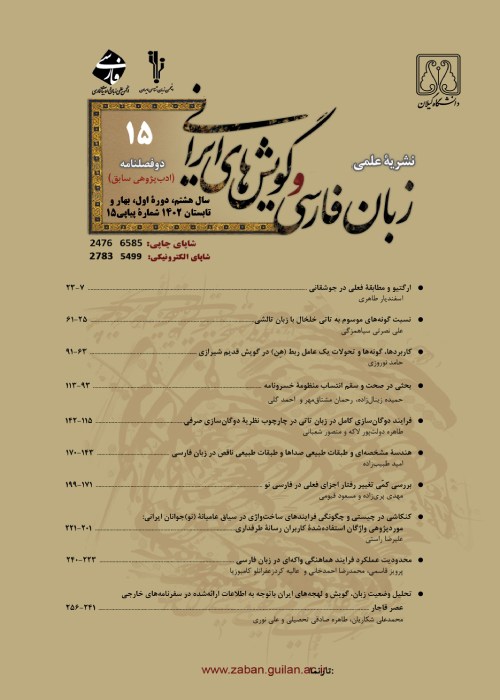A Minimalist Approach to the Syntactic Clause-Typing of the Imperatives in Persian
Author(s):
Article Type:
Research/Original Article (دارای رتبه معتبر)
Abstract:
Introduction Structures such as interrogatives, declaratives and imperatives are employed in all languages (Sadock & Zwicky, 1985). These sentences belong to a closed and restricted set, and most importantly, each of these structures is associated with its own specific force in the syntactic construction of the sentence (ibid.). The question that arises in this regard is how the force of each of these sentences is activated in the sentence? Along the same lines, it has been suggested that these sentences should be formally typed in different languages, that is, there needs to be a syntactic mechanism thorough which one can determine the specific type of each of these sentences or illustrate the way they are licensed. In this approach, each of the sentences has a specific element that encodes or types its special force, and this element is placed at the top of the hierarchical structure of the sentence and in particular in the Complementizer Phrase (CP) (e.g., Cheng, 1991; Rizzi, 1990, 1996; Rivero &Terzi, 1995, Han, 1998).
Accordingly, it has been assumed that the imperative constructs lack a syntactic subject, and the verb is placed in the head of ForceP in order to satisfy the clause typing or licensing requirement (Han, 1998, 1999a-b, 2000, 2001). More precisely, it has been proposed that either the verb is overtly placed in the head of ForceP, or it must move at the stage during the derivation of the sentence to the head of ForceP in order to provide the imperative reading (ibid.). In this approach, the head of ForceP has features that provide the required interpretation for the sentence, and this requirement implies that the verb overtly moves to this position. But in some languages, such relocation is not plausible. In the latter case, it is necessary that the verb is linked to this position in some other way (ibid.). Given this, this paper attempts to shed some light on how the clause typing mechanism is realized in the imperative sentences in Persian.
Theoretical framework The theoretical framework of this paper is the theory of feature checking within the Minimalist Program (e.g. Chomsky, 1995; 2001a-b) as well as the Split-CP Hypothesis (Rizzi, 1997). Feature checking is actually triggered by the need to eliminate [-Interpretable] formal features from the computation (Hornstein et al, 2005: 286), which can be accomplished either through Move-F or Agree. In Rizzis (1997) analysis, the CP-phasewhich expresses Force (declarative, interrogative, etc.) and Finiteness are divided intoForceP, Topic Phrase, Focus Phrase,and Finite Phrase (IP).
Methodology This research is descriptive-analytical in nature. The data were randomly collected from different contexts of the spoken form of the Standard Persian before they were scrutinized and formulated by the researchers.
Results & Discussion In this paper, it is first argued that of the presence of an imperative verbin the head of the ForceP or the movement of this element to such a position is impossible in imperative structures in Persian. Hence, the hypothesis that in imperative sentences in all languages the verb should be moved in the head of ForceP falls short of efficiency for Persian data, and thus it is necessary to introduce another mechanism for the syntactic typing of imperatives in Persian.
Therefore, it is suggested that since the verb in the unmarked positive and negative constructs remains in its secondary position in the head of vPand its displacement into the core of the ForceP with the aim of clause typing is impossible, an Agree mechanism can make it possible for this requirement to be satisfied from distance through checking and valuing the features.
On the other hand, in the marked positive imperative structures, the verb raises to Topo and Foco as the final landing sites to check and value the [-Top] and [-Foc] features on the corresponding heads and provide the topic and focus interpretations, respectively. After that, due to the fact that further raising of the verb in overt syntax is blocked, it was suggested that in the affirmative imperatives the [-IMP] feature on the Forceo should be matched with the [] feature on the verb via Agree, by means of which the [-IMP] feature on the Forceo is checked and valued.
In the negative imperatives, however, it was proposed that the [] feature on the verb must undergo Move-F to Forceo, leaving behind the [㗨] feature on the verb in Topo or Foco heads. Being stranded on the verb in Topo and Foco, the [㗨] feature does not out-scope the [-IMP] feature on Forceo, and consequently, a contradictory interpretation would not be yielded.
Conclusions & Suggestions In this article, it was argued that in the positive unmarked imperatives, clause-typing is satisfied through establishing an Agree relation between [] on the verb and [-IMP] on Forceo, and in the negative unmarked imperatives, the clause-typing requirement is accomplished via the Move-F of [] on the verb to Forceo, stranding [㗨] on the verb. In the marked imperative structures, however, first the verb is preposed, landing in the head of either TopP or FocP. Then, in the positive marked structures, [] on the verb is matched with [-IMP] on Forceo through Agree, whereas in the negative marked constructions, [] on the preposed verb undergoes Move-F to Forceo, stranding [㗨] on the verb.
Accordingly, it has been assumed that the imperative constructs lack a syntactic subject, and the verb is placed in the head of ForceP in order to satisfy the clause typing or licensing requirement (Han, 1998, 1999a-b, 2000, 2001). More precisely, it has been proposed that either the verb is overtly placed in the head of ForceP, or it must move at the stage during the derivation of the sentence to the head of ForceP in order to provide the imperative reading (ibid.). In this approach, the head of ForceP has features that provide the required interpretation for the sentence, and this requirement implies that the verb overtly moves to this position. But in some languages, such relocation is not plausible. In the latter case, it is necessary that the verb is linked to this position in some other way (ibid.). Given this, this paper attempts to shed some light on how the clause typing mechanism is realized in the imperative sentences in Persian.
Theoretical framework The theoretical framework of this paper is the theory of feature checking within the Minimalist Program (e.g. Chomsky, 1995; 2001a-b) as well as the Split-CP Hypothesis (Rizzi, 1997). Feature checking is actually triggered by the need to eliminate [-Interpretable] formal features from the computation (Hornstein et al, 2005: 286), which can be accomplished either through Move-F or Agree. In Rizzis (1997) analysis, the CP-phasewhich expresses Force (declarative, interrogative, etc.) and Finiteness are divided intoForceP, Topic Phrase, Focus Phrase,and Finite Phrase (IP).
Methodology This research is descriptive-analytical in nature. The data were randomly collected from different contexts of the spoken form of the Standard Persian before they were scrutinized and formulated by the researchers.
Results & Discussion In this paper, it is first argued that of the presence of an imperative verbin the head of the ForceP or the movement of this element to such a position is impossible in imperative structures in Persian. Hence, the hypothesis that in imperative sentences in all languages the verb should be moved in the head of ForceP falls short of efficiency for Persian data, and thus it is necessary to introduce another mechanism for the syntactic typing of imperatives in Persian.
Therefore, it is suggested that since the verb in the unmarked positive and negative constructs remains in its secondary position in the head of vPand its displacement into the core of the ForceP with the aim of clause typing is impossible, an Agree mechanism can make it possible for this requirement to be satisfied from distance through checking and valuing the features.
On the other hand, in the marked positive imperative structures, the verb raises to Topo and Foco as the final landing sites to check and value the [-Top] and [-Foc] features on the corresponding heads and provide the topic and focus interpretations, respectively. After that, due to the fact that further raising of the verb in overt syntax is blocked, it was suggested that in the affirmative imperatives the [-IMP] feature on the Forceo should be matched with the [] feature on the verb via Agree, by means of which the [-IMP] feature on the Forceo is checked and valued.
In the negative imperatives, however, it was proposed that the [] feature on the verb must undergo Move-F to Forceo, leaving behind the [㗨] feature on the verb in Topo or Foco heads. Being stranded on the verb in Topo and Foco, the [㗨] feature does not out-scope the [-IMP] feature on Forceo, and consequently, a contradictory interpretation would not be yielded.
Conclusions & Suggestions In this article, it was argued that in the positive unmarked imperatives, clause-typing is satisfied through establishing an Agree relation between [] on the verb and [-IMP] on Forceo, and in the negative unmarked imperatives, the clause-typing requirement is accomplished via the Move-F of [] on the verb to Forceo, stranding [㗨] on the verb. In the marked imperative structures, however, first the verb is preposed, landing in the head of either TopP or FocP. Then, in the positive marked structures, [] on the verb is matched with [-IMP] on Forceo through Agree, whereas in the negative marked constructions, [] on the preposed verb undergoes Move-F to Forceo, stranding [㗨] on the verb.
Keywords:
Language:
Persian
Published:
Journal of Persian language and Iranian dialects, Volume:2 Issue: 2, 2018
Pages:
7 to 33
magiran.com/p1821761
دانلود و مطالعه متن این مقاله با یکی از روشهای زیر امکان پذیر است:
اشتراک شخصی
با عضویت و پرداخت آنلاین حق اشتراک یکساله به مبلغ 1,390,000ريال میتوانید 70 عنوان مطلب دانلود کنید!
اشتراک سازمانی
به کتابخانه دانشگاه یا محل کار خود پیشنهاد کنید تا اشتراک سازمانی این پایگاه را برای دسترسی نامحدود همه کاربران به متن مطالب تهیه نمایند!
توجه!
- حق عضویت دریافتی صرف حمایت از نشریات عضو و نگهداری، تکمیل و توسعه مگیران میشود.
- پرداخت حق اشتراک و دانلود مقالات اجازه بازنشر آن در سایر رسانههای چاپی و دیجیتال را به کاربر نمیدهد.
In order to view content subscription is required
Personal subscription
Subscribe magiran.com for 70 € euros via PayPal and download 70 articles during a year.
Organization subscription
Please contact us to subscribe your university or library for unlimited access!



